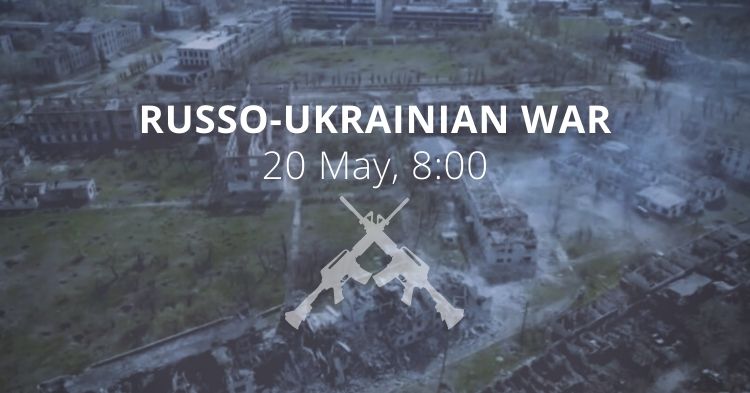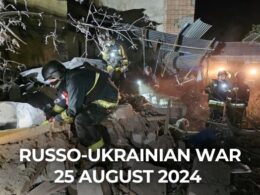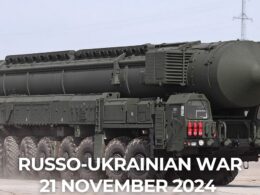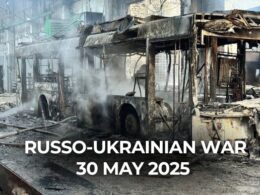The battle for the Donbas continues as the situation in Ukraine's east currently remains the most tense. As Russia attacks Lysychansk and Sievierodonetsk, it is also intensifying its attacks to advance north and west of Popasna threatening to seal up the Sievierodonetsk metropolitan area.
Morning report day 86 – May 20
The report is based on media reports, expert analyses, and official information posted online.
Situation
According to information from the General Staff as of 06.00 20.05.2022, supplemented by its [18:00 assessment].
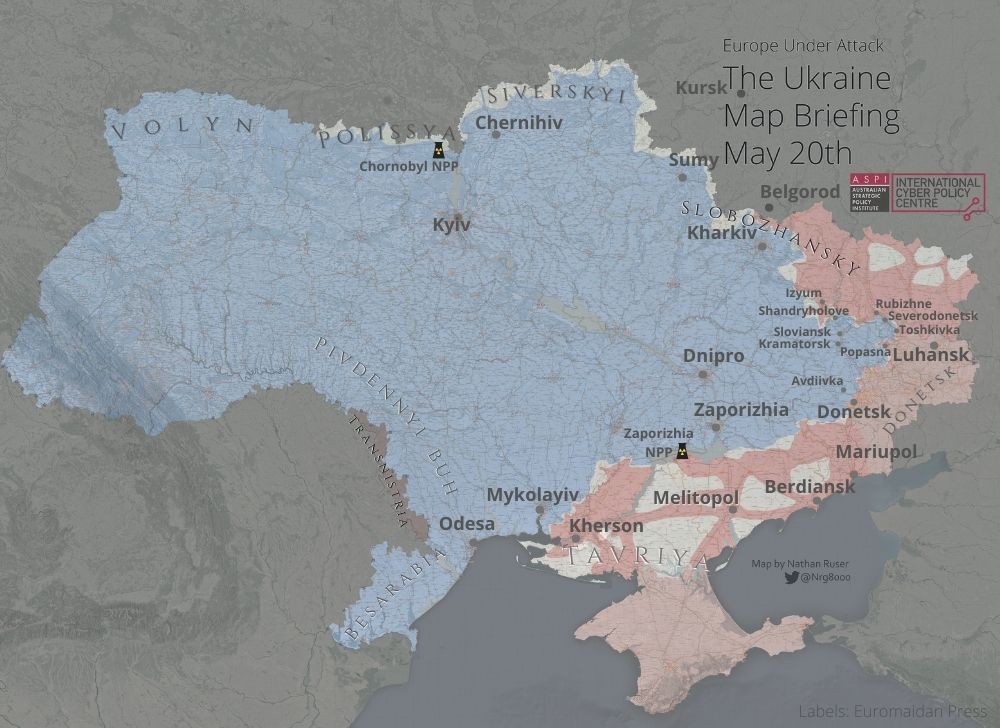
There are no significant changes in the state and position of units of the Armed Forces of the Republic of Belarus in the Volyn and Polissia directions. The threat of missile and bomb strikes remains from the territory of the Republic of Belarus.
In the Siverskyi direction, the enemy carries out engineering equipment of positions around the settlement of Azarovka in Bryansk region. [To clarify the position of our units, artillery positions and deployment routes, the Russian forces conducted air reconnaissance with the help of UAVs.]
- It fired artillery and mortar shells at the settlements of Boyaro-Lezhachi, Brusky, Staryi Vyrky, Sumy Oblast, and Hremyach, Chernihiv Oblast.
- [The Russian forces fired artillery and mortars at the border settlements of the Sumy region: Esman, Sopych and Seredyna-Buda.]
[In the Slobozhansky direction, the Russian forces focused their efforts on maintaining their occupied positions and preventing the Defense Forces from advancing into the temporarily occupied territory. In some areas, he tried to conduct unsuccessful counterattacks to restore lost positions.]
- In the Kharkiv direction, Russian forces' main efforts are focused on maintaining the occupied frontiers. It tries to counterattack to restore the lost positions. Conducts enhanced air reconnaissance with the use of UAVs.
- Fighting continued in the area of the settlements of Ternova and Vesele. In addition, Russian forces shelling was recorded near Ruski Tyshki.
- In the Sloviansk direction, Russian forces fired on civilian infrastructure in the area of the settlements of Dovhenke, Velyka Komyshuvakha and Dolyna. [Yesterday, they fired on civilian infrastructure in the areas of the settlements of Pryshyb, Hrushuvakha and Bohorodichne.]
In the Donetsk direction, Russian forces intensified offensive and assault operations to improve the tactical situation. It inflicted fire damage from mortars, artillery, multiple rocket launchers and operational and tactical aircraft to destroy the fortifications of our units along the entire line of contact.
- In the Lyman direction, Russian forces carry out periodic shelling of civilian infrastructure in the areas of the settlements of Dibrova and Zakitne. [Yesterday, the Russian forces did not conduct offensive operations, firing on civilian infrastructure in the areas of Ozerne and Lyman.]
- In the Sievierodonetsk direction, Russian forces carried out assault operations in the direction of the settlement of Sievierodonetsk, had no success, suffered losses and were forced to retreat. Conducts hostilities in the area of Toshkivka.
- [Yesterday, the occupiers carried out offensive operations in the area of the settlement of Oleksandropil (until 2016 - Rozivka) of the Yasynuvata district and tried to improve the tactical situation in the areas of the settlements of Pylypchatyne, Druzhba and Trypillya. They are not successful.]
- In the Bakhmut direction, with the support of artillery and mortars, Russian occupiers carried out offensive operations in the area of the settlement of Vyskryva, while trying to improve the tactical position of their units near Volodymyrivka and Vasylivka. Russian occupiers suffered losses in the area of the settlement of Alexandropil.
- In the Avdiivka direction, Russian forces, with the support of artillery, conducted assault and offensive operations in the area of the settlement of Vesele. It suffered losses and retreated. [Yesterday, with the support of artillery, the Russian forces conducted assault operations in the area of Novobakhmutovka, had no success, suffered losses and retreated.]
- In the Kurakhiv direction, Russian forces carried out massive artillery shelling of civilian infrastructure, including multiple rocket launchers. It conducted an offensive in the Novomykhailivka and Oleksandrivka districts but was unsuccessful. [Yesteday, the Russian forces, with the support of MLRS and heavy flamethrower systems, launched an offensive in the areas of the settlements of Stepne, Slavne and Mariinka, without success.]
- Fourteen enemy attacks were repulsed in the Donetsk and Luhansk directions over the past 24 hours, eight tanks, fourteen units of combat armoured vehicles and six units of forces vehicles were destroyed. Air defence units shot down one Orlan-10 UAV.
In the Novopavlivsk and Zaporizhzhia directions, Russian forces hit infrastructure and peaceful households with rocket and artillery and mortar fire and waged a counter-battery struggle. In the area of the settlement of Novodarivka, it suffered losses and retreated to its former positions.
Russian invaders did not carry out active hostilities in the Pivdennyi Buh direction. They fired on houses with mortars and artillery. The engineering equipment of the positions and the construction of the second line of defence continued. [Strengthened the grouping of electronic warfare units.]
- There is a high probability of continuing hostilities in order to improve the tactical situation and reach the administrative border of the Kherson region.
- The situation in the Besarabian direction remained without significant changes. [The situation in the Transnistrian region of the Republic of Moldova has not changed.]
Russian naval forces in the Black and Azov Seas continue to block civilian shipping.
[In the temporarily occupied territories of Ukraine, the Russian forces continue to take measures on the administrative and police regime, violate the rights and freedoms of civilians, and prohibit free movement and relocation to the territory controlled by the Government of Ukraine.]
[The personnel of the Russian forces are demoralized, and the promised payments for participation in hostilities by the command of the Russian occupation forces are not made. Personnel continue to suffer significant losses in battles with the Defense Forces of Ukraine. Cases of desertion of individual units of the occupying forces are recorded.]”
In Kharkiv oblast, 23 Settlements have been liberated from Russian occupation since May 5, Brigadier General Oleksiy Hromov, Deputy Chief of the Main Operations Department of the Ukrainian General Staff said at a press conference in Media Center Ukraine - Ukrinform English on May 19, 2022.
“In the Kharkiv area, 23 settlements have been liberated from the Russian occupation since May 5. The Russian forces try to contain our forces’ offensive. Russia does not stop shelling Chernihiv and Sumy Oblasts to divert our forces from core combat areas,” he said.
Oleksii Hromov emphasized that the operative goal of Russian invaders has remained unchanged: Reaching the administrative boundaries of Donetsk and Luhansk Oblasts. In the Donetsk area, the foe tries to attack the entire frontline using air support. Active fighting takes place in Sievierodonetsk, Lyman, Bakhmut, Avdiivka, and Kurakhove areas. The Russian forces are gradually losing their offensive capability. There is a certain probability of combat operations in other areas to prevent the projection of our forces.
“In the Black Sea and the Sea of Azov, there is a persistent threat of missile strikes on the territory of Ukraine from Russian vessels. In addition, the invaders’ ships block commercial navigation. The foe keeps engaging in provocations to simulate the threat of amphibious assault,” the brigadier general said.
“Arson attacks on military registration and enlistment offices have become a constant feature of life in Russia since the start of the all-out war in Ukraine. Five arsons happened over the last week—in Rostov and Ryazan Oblasts, and also in Volgograd and Omsk,” he said.
Oleksii Hromov indicated that the invaders started fortifying their positions in Ziabrovka airfield in Homiel Oblast [Belarus, 90 km north of Chernihiv]; the use of this airfield by Russia as its military base cannot be ruled out. The situation in Transnistria remains tense. All Russian personnel in this area has been put on full combat alert.”
Palamar: Azov Regiment command stays in Azovstal’s territory, the Ukrinform reports.
Deputy Commander of the Azov Regiment, Captain Sviatoslav Palamar (call sign Kalyna) recorded a video in which he denies the information that he left the territory of the Azovstal steelworks in Mariupol and surrendered to Russian invaders. "The command and I are in the territory of Azovstal steelworks. An operation is underway, the details of which I will not disclose. I want to thank the whole world and Ukraine for support. See you," he said. Ukrainian war correspondent Andriy Tsaplienko published the relevant video on Telegram.
Donetsk Oblast: Russian troops fail to block the road to Bakhmut, the Ukrainska Pravda reports. Russian troops failed to block the road to Bakhmut in Donetsk Oblast; the Ukrainian Armed Forces repulsed the Russian attack, Pavlo Kyrylenko, the Head of Donetsk Oblast Military Administration, said on Ukraine’s national 24/7 newscast, and cited by Radio Svoboda
Zaluzhnyi: Russian missile strikes pose threat to Ukraine, NATO member states, the Ukrinform reports.
Russians are maintaining missile fire of high intensity, on average 10-14 ballistic and cruise missiles per day. This is a threat not only to Ukraine but also to NATO member states. After all, each such missile carries 400-600 kg of TNT. Therefore crucial to strengthen missile defence,” Zaluzhnyi underscored.
According to British Defence Intelligence, (last 24 hours):
- As many as 1,700 Ukrainian soldiers are likely to have surrendered from the Mariupol Azovstal steel factory. An unknown number of Ukrainian forces remain inside the factory. Once Russia has secured Mariupol, it is likely they will move their forces to reinforce operations in the Donbas.
- Staunch Ukrainian resistance in Mariupol since the start of the war means Russian forces in the area must be re-equipped and refurbished before they can be redeployed effectively. This can be a lengthy process when done thoroughly.
- Russian commanders, however, are under pressure to demonstrably achieve operational objectives. This means that Russia will probably redistribute their forces swiftly without adequate preparation, which risks further force attrition.
As of Friday 20 May, the approximate losses of weapons and military equipment of the Russian Armed Forces from the beginning of the war to the present day:
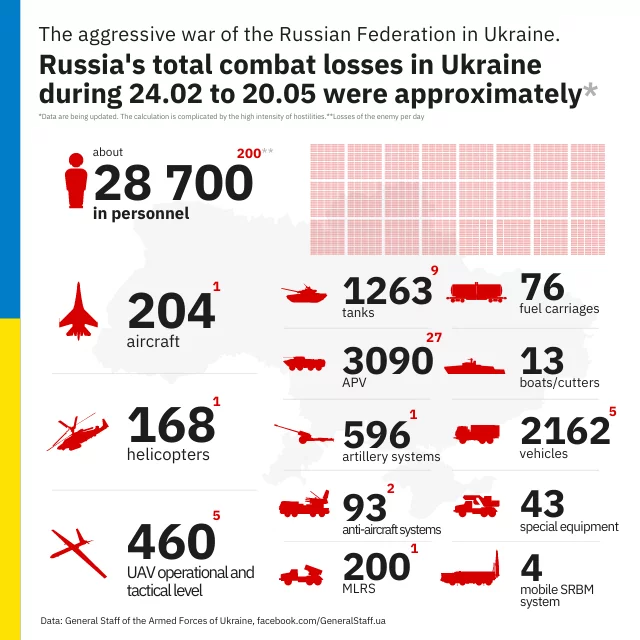
Russian enemy suffered the greatest losses (of the last day) in the Bakhmut direction.
Humanitarian
In the Zaporizhzhia oblast occupying forces not letting people pass through the checkpoint: more than a thousand cars are queueing, the Ukrainska Pravda reports. "At the moment, in Vasylivka, in front of the checkpoint of the Russian Federation, there are more than 1,000 vehicles that are not being allowed to pass either into Ukrainian controlled territory or into the occupied territories. The occupiers are not allowing them to pass through to either side", the Deputy Chairman of the Zaporizhzhia Regional State Administration, Zlata Nekrasova, wrote on Facebook.
International Committee of the Red Cross registers all combatants leaving the Azovstal plant, the Ukrainska Pravda reports. A team from the International Committee of the Red Cross says they have registered hundreds of Ukrainian prisoners of war this week from the Azovstal plant in Mariupol, according to the International Committee of the Red Cross (ICRC), as well as the Russian Kremlin-aligned news agency "RIA Novosti".
“The registration process that the ICRC facilitated involves filling out a form with personal details like name, date of birth, and next of kin. This information allows the Committee to track those who have been captured and help them keep in touch with their families.
In accordance with the mandate given to the ICRC by the states parties to the 1949 Geneva Conventions, the Committee must have immediate access to all prisoners of war in all places where they are held. The ICRC must be allowed to interview them without witnesses, and the duration and frequency of these visits should not be unduly restricted.”
Hundreds of Mariupol defenders surrender in Mariupol, the KyivPost reports. RF-controlled news platforms late on May 18 claimed Sviatoslav Palamar, second in command of the Azov National Guard Regiment, walked out of the Azovstal plant in Mariupol at 21:00 to be taken into custody by Russian Federation (RF) troops.
“At least 1,750 Ukrainian fighters have laid down arms since a Tuesday agreement between UAF and RF negotiators to end the steel mill’s siege, reported Dmitriy Steshin, a correspondent for the Kremlin-controlled Komsomolskaya Pravda news platform.
Ukrainian officials did not state precise numbers of Ukrainian troops having quit fighting and gone into RF custody but confirmed the surrender process was continuing peacefully. Presidential Advisor Oleksiy Arestovych in a late May 18 television interview, said a large proportion of the Mariupol defenders had surrendered, and that talks were in progress on terms for the last UAF fighters still in the steel factory to cease resistance.”
According to UNHCR 6,361,116 refugees have been registered as of May 18. The UN says that so far Poland has taken in 3,418,077 refugees, Romania 937,082, Russian Federation 875,597, Hungary 620,846, Republic of Moldova 466,406, Slovakia 429,705 and Belarus 27,308. Among those who fled Ukraine are also Ukrainian nationals with dual citizenship. An additional 105,000 people moved to the Russian Federation from the Donetsk and Luhansk regions between 18 and 23 February.
The number of Ukrainians entering Ukraine since February 28 is 1,887,500 as of May 18. This figure reflects cross-border movements, which can be pendular, and does not necessarily indicate sustainable returns.
OHCHR recorded 8,089 civilian casualties in Ukraine as of May 18. 3,811 were killed (including 255 children) and 4,278 injured (including 382 children).
Environmental
The war in Ukraine is exacerbating the global hunger crisis, UN officials say, The New York Times reports. “A perfect storm, created by the war in Ukraine combined with the effects of climate change and the pandemic, has driven global hunger levels to a new high, United Nations officials said on Thursday.
 At least 276 million people now face acute food insecurity, up from 135 million before the pandemic, and 49 million people in 43 countries are at the brink of famine, officials said during two days of events at the United Nations this week on the theme of global food security.
At least 276 million people now face acute food insecurity, up from 135 million before the pandemic, and 49 million people in 43 countries are at the brink of famine, officials said during two days of events at the United Nations this week on the theme of global food security.
“We truly are in an unprecedented crisis. Food pricing is our number one problem right now, as a result of all this perfect storm for 2022. But in 2023 it very well will be a food availability problem,” David Beasley, the executive director of the UN’s World Food Program, said at a Security Council meeting on Thursday.
Ukraine and Russia together produced 30 percent of the world’s wheat supplies before the war
, and Russia and Belarus were major exporters of fertilizers, according to the UN The war has disrupted supply chains, and fuel prices have increased as a result of the fighting and sanctions targeting Russia’s energy and banking sectors.
Rising prices for basic food items have sparked political unrest in many countries in the past few weeks, including Sri Lanka Indonesia, Pakistan, Iran and Peru. Africa remains extremely vulnerable to food insecurity, according to the UN, and hunger looms in eastern African countries suffering from droughts, such as Ethiopia, Somalia and Kenya.”
EU Statement on the Russian Federation’s ongoing aggression against Ukraine.
“During the last 12 weeks, we have witnessed the most devastating war on European soil since the Second World War, as Russia continues its aggression and its attempt to subdue the peaceful and democratic neighbouring State of Ukraine by the use of force. […]
The indiscriminate targeting of civilians and civilian infrastructure, the shooting of innocent civilians in their heads and backs that the whole world witnessed last week, the looting of homes and businesses, demonstrate the deplorable tactics of the Russian army, many of which may amount to war crimes.
[…] Russia’s war of aggression against Ukraine is not only being waged with tanks, shells, mines, trenches and terror, it is also being pursued through disinformation and information manipulation, intimidation, false narratives, and a campaign of cultural destruction. […]
Russia’s aggression in Ukraine has already created a humanitarian disaster, especially in the regions under Russian military control where the so-called “authorities” are not able to provide the local population with food, medicine and other basic goods.
Russia is also targeting Ukraine’s agriculture, including fields, farm equipment, warehouses, fuel storage facilities and markets, apparently intending to cripple Ukraine’s agricultural economy, thereby cutting off a major source of Ukraine’s income but also creating a food crisis, possibly of global proportions. Before the invasion, Ukraine supplied 12% of the planet’s wheat, 15% of its corn and half of its sunflower oil. Russia’s blocking of the exit routes for Ukraine’s grain, including its ports, makes the world face a worsening state of food insecurity and malnutrition. This is at a time when 43 million people are already one-step away from famine. […]
Furthermore, we have already recorded examples of how human rights and democratic principles were eroded where Russia has interfered in past years. This includes in the non-government controlled areas of Donetsk and Luhansk oblasts of Ukraine and in the illegally annexed the Crimean peninsula, where political opposition is stifled and persecuted, civil society curbed, journalists silenced and the rights of persons belonging to different communities, in particular Crimean Tatars, suppressed.
The European Union condemns Russia’s premeditated, unprovoked, unjustified and illegal war of aggression against Ukraine in the strongest possible terms. We call on Russia to immediately and unconditionally cease its military actions and withdraw all its troops and equipment from the entire territory of Ukraine, including the illegally annexed Crimean peninsula. We also reiterate our call on Belarus to stop enabling the Russian aggression and to abide by its international obligations.”
Ukraine's Zelenskyy says the Donbas region has been completely destroyed, the Reuters reports. “President Zelenskyy on Thursday said Russian forces had "completely destroyed" the industrial Donbas region and accused Moscow of carrying out senseless bombardments as it intensified its offensive. Zelenskyy also accused Russian forces of attempting to kill as many Ukrainians and do as much damage as possible, repeating his charge that Russia was carrying out a genocide.”
Legal
Kharkiv Oblast Administration: Russian occupiers fail to force Izium residents into conscription, the Ukrainska Pravda reports. According to our information, they tried to force Izium residents into conscription, but their attempts failed. “They forced people to either leave Izium for the Russian Federation or join the Russian armed forces. They made them choose between these two options. We have no information about any residents who have agreed to join the Russian armed forces," Oleh Syniehubov, Head of Kharkiv Oblast Military Administration, said in an interview for Focus.
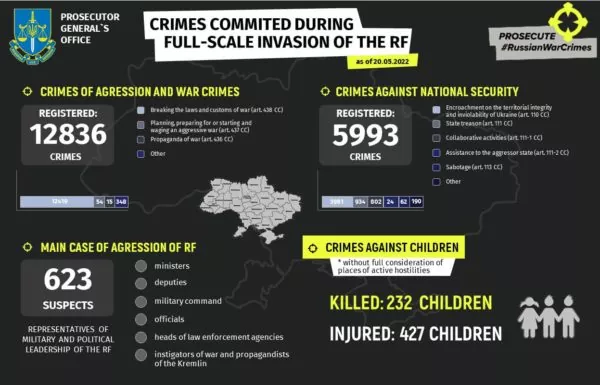 232 children were killed, and 427 children injured, the Office of the Prosecutor General of Ukraine reports as of May 20. 1,837 educational establishments are damaged as a result of shelling and bombings, 172 of them are destroyed fully. 12,836 crimes of aggression and war crimes and 5,993 crimes against national security were registered.
232 children were killed, and 427 children injured, the Office of the Prosecutor General of Ukraine reports as of May 20. 1,837 educational establishments are damaged as a result of shelling and bombings, 172 of them are destroyed fully. 12,836 crimes of aggression and war crimes and 5,993 crimes against national security were registered.
Support
The US deepens its Ukraine commitment with $40 billion in aid, The Washington Post reports. “President Biden and Congress on Thursday deepened US involvement in the global effort to reject the Russian invasion of Ukraine, with the Senate voting to finalize more than $40 billion in new military and humanitarian assistance while Biden and top lawmakers lent firm public support to what could be the most significant expansion of NATO in nearly two decades.
The events came as America and its allies pivot to planning for a longer war in Ukraine, the scope of which has narrowed since the initial Russian invasion three months ago but whose duration appears increasingly lasting as the fighting enters a gruelling new phase.
The bill, passed on an 86-to-11 vote Thursday, provides a combined $20 billion in military aid that is expected to finance the transfer of advanced weapons systems, such as Patriot antiaircraft missiles and long-range artillery. Also included in the bill is more than $8 billion in general economic support for Ukraine, nearly $5 billion in global food aid to address potential food shortages sparked by the collapse of the Ukrainian agricultural economy, and more than $1 billion in combined support for refugees.”
According to the Reuters, the military aid part of the package includes “almost $15 billion for defence operations and maintenance, which includes $6 billion for the Ukraine Security Assistance Initiative and $8.7 billion to replenish stocks of US equipment sent to Ukraine. The legislation includes hundreds of millions of dollars for the procurement of missiles, weapons and tracked combat vehicles, ammunition and aircraft, among others.
It also provides $4 billion in Foreign Military Financing to provide support for Ukraine and other countries affected by the crisis, and $100 million for non-proliferation, anti-terrorism, demining and related programs.
The legislation authorizes up to a further $11 billion in Presidential Drawdown Authority, which allows the president to authorize the transfer of articles and services from US stocks without congressional approval in response to an emergency.”
The US sends an additional $100 million in military equipment to Ukraine, The Washington Post reports. “The separate $100 million in equipment includes 18 additional 155 mm howitzers, a weapon that can fire longer-range shells, Defense Department spokesman John Kirby said. The United States has sent howitzers in several prior aid packages.” According to the Ukrinform, the Armed Forces of Ukraine will also receive three AN/TPQ-36 counter-artillery radars.
EU exploring ways to use Russian oligarchs' frozen assets to rebuild Ukraine
, the Reuters reports. “The European Union is looking into ways of using the frozen assets of Russian oligarchs to fund the reconstruction of Ukraine after the war, European Commission President Ursula von der Leyen said on Thursday. Our lawyers are working intensively on finding possible ways of using frozen assets of the oligarchs for the rebuilding of Ukraine. I think Russia should also make its contribution, she told ZDF television.
Von der Leyen also said she favoured coupling the long-term reconstruction of Ukraine with reforms needed for it to join the European Union. While Ukrainians see their future within the EU, certain standards have to be met for membership in areas such as the rule of law and in the economic and political spheres, she said. We will have to co-finance the reconstruction of Ukraine ... it makes sense to tackle reforms at the same time, for example against corruption or building up the rule of law, she said.”
In Russia, as Prices Soar, the Outlook for Its Economy Grows ‘Especially Gloomy’, The New York Times reports. “The economic prospects for Russia are especially gloomy,” the Bank of Finland said in an analysis this month. “By initiating a brutal war against Ukraine, Russia has chosen to become much poorer and less influential in economic terms.” Even the Central Bank of Russia has predicted a staggering inflation rate between 18 and 23 percent this year, and a falloff in total output of as much as 10 percent.
It is not easy to figure out the impact of the war and sanctions on the Russian economy at a time when even using the words “war” and “invasion” are illegal. President Vladimir V. Putin has insisted that the economy is weathering the measures imposed by the United States, Europe and others.
Financial maneuvers taken by Moscow helped blunt the economic damage initially. At the start of the conflict, the central bank doubled interest rates to 19 percent to stabilize the currency, and recently was able to lower rates to 14 percent. The ruble is trading at its highest level in more than two years. And even though Russia has had to sell oil at a discount, dizzying increases in global prices are causing tax revenues from oil to surge past $180 billion this year despite production cuts, according to Rystad Energy. Natural gas deliveries will add another $80 billion to Moscow’s treasury. […]
Analysts say that the rift with many of the world’s largest trading partners and technological powerhouses will inflict deep and lasting damage on the Russian economy. “The really hard times for the Russian economy are still in front of us,” said Laura Solanko, a senior adviser at the Bank of Finland Institute for Emerging Economies. The stock of supplies and spare parts that are keeping businesses humming will run out in a few months, Ms. Solanko said. At the same time, a lack of sophisticated technology and investment from abroad will hamper Russia’s productive capacity going forward.
The Russian Central Bank has already acknowledged that consumer demand and lending are on a downhill slide, and that “businesses are experiencing considerable difficulties in production and logistics.”
New developments
- Ukraine Should Return Donbas and Crimea to Win the War - Dmytro Kuleba, the European Pravda reports. "We must win at all costs because if we lose, Ukraine will disappear and there will be a completely different Europe. Liberation of the occupied territories, including Crimea and Donbas. Reparations by Russia. Trial of Russian war crimes and crimes against humanity. Anchoring Ukraine in European integration. Those are the four elements that go with a win for me." "One of the reasons for this war is that politicians in Europe and the US have been too accommodating to Putin. It was always others who had to make concessions to satisfy him. It's time to turn things around", Minister for Foreign Affairs of Ukraine Dmytro Kuleba said in an interview with the local newspaper NRC in the Netherlands.
- Top US and Russian generals speak for the first time since the Ukraine invasion, the Reuters reports. The chairman of the US Joint Chiefs of Staff, “General Mark Milley, spoke by telephone with Russia's Chief of General Staff Valery Gerasimov, the Pentagon said on Thursday, the first conversation between the two since Russia's invasion of Ukraine in February. The military leaders discussed several security-related issues of concern and agreed to keep the lines of communication open, said a spokesman for Milley.”
- Russia openly declares that the war in Ukraine is a war with the West, the Ukrainska Pravda reports. "Equally, we understand that it is not Ukraine that Russia is fighting in the special operation on the territory of Ukraine. Rather, the united West is fighting against us on Ukrainian territory through the hands of the Ukrainians," Sergey Kiriyenko, First Deputy Chief of Staff of the Russian Presidential Administration, has said according to the Kremlin-aligned Russian news agency RIA Novosti.
- FM Kuleba: NATO as an institution has done nothing for Ukraine during the war, the Ukrinform reports. “Minister of Foreign Affairs of Ukraine Dmytro Kuleba considers that NATO as an institution has done nothing to help Ukraine over the past three months. The EU has proven to be an organization capable of acting as a united front and making powerful, important, difficult decisions in contrast to NATO. Could you name at least one consensus decision made by NATO over the past three months that would benefit and help Ukraine? the minister said.
Kuleba added that before the war, the Ukrainian society had seen NATO as a force and the EU as something weak and capable only of expressing concern. The war showed that, on the contrary, the EU made historic and revolutionary decisions on the provision of weapons, sanctions, recognition of the European perspective, and economic decisions. "Yes, it is true that the Alliance members, individually or in small groups, are really doing awesome and important work, providing vital assistance. There are no questions. But NATO as an institution has done nothing during this time," Kuleba said”.
- Blinken accuses Russia of using food as a weapon in Ukraine, the Reuters reports. “US Secretary of State Antony Blinken accused Russia on Thursday of using food as a weapon in Ukraine by holding "hostage" supplies for not just Ukrainians, but also millions around the world. Addressing the United Nations Security Council, Blinken appealed to Russia to stop blockading Ukrainian ports. […]
The war in Ukraine has caused global prices for grains, cooking oils, fuel and fertilizer to soar. Russia and Ukraine together account for nearly a third of global wheat supplies. Ukraine is also a major exporter of corn, barley, sunflower oil and rapeseed oil, while Russia and Belarus - which has backed Moscow in its war in Ukraine - account for more than 40% of global exports of potash, a crop nutrient.”
Assessment
On the War
The Institute for the Study of War has made the following assessment as of Thursday 19 May:

Russian forces are continuing to suffer shortages of reserve manpower, causing the Russian military command to consolidate depleted battalion tactical groups (BTGs). An unnamed US defense official reported that Russian forces still have 106 BTGs operating in Ukraine but had to disband and combine some to compensate for losses. Ukrainian General Staff Main Operations Deputy Chief Oleksiy Gromov reported that Russian forces are combining units of the Pacific and Northern Fleets at the permanent locations of the 40th Separate Marine Brigade and the 200th Separate Motorized Rifle Brigade, respectively. Gromov added that Russian forces are training servicemen in Krasnodar Krai to replenish units of the 49th Combined Arms Army and are trying to restore combat power of Russian units withdrawn from the battlefront in occupied Crimea.
Unknown Russian perpetrators conducted a series of Molotov cocktail attacks on Russian military commissariats throughout the country in May, likely in protest of covert mobilization. Russian media and local Telegram channels reported deliberate acts of arson against military commissariats in three Moscow Oblast settlements—Omsk, Volgograd, Ryazan Oblast, and Khanty-Mansi Autonomous District—between May 4 and May 18. Ukrainian General Staff Main Operations Deputy Chief Oleksiy Gromov said that there were at least 12 cases of deliberate arson against military commissariats in total and five last week. Russian officials caught two 16-year-olds in the act in one Moscow Oblast settlement, which suggests that Russian citizens are likely responsible for the attacks on military commissariats.
Key Takeaways
- Russian forces are intensifying operations to advance north and west of Popasna in preparation for an offensive toward Sievierodonetsk.
- Russian and proxy authorities in Mariupol are struggling to establish coherent administrative control of the city.
- Russian forces reportedly attempted to regain control of the settlements they lost during the Ukrainian counteroffensive north of Kharkiv City.
- Russian forces are bolstering their naval presence around Zmiinyi (Snake) Island to fortify their grouping on the island.“
Consequences and what to do?
ME: The Ukrainian Minister of Foreign Affairs stressed that NATO as an institution has done nothing to help Ukraine over the past three months. Kuleba added that before the war, the Ukrainian society had seen NATO as a force and the EU as something weak and capable only of expressing concern. The war has shown that, on the contrary, the EU made historic and revolutionary decisions on the provision of weapons, sanctions, recognition of the European perspective, and economic decisions. Alliance members, individually or in small groups, are doing awesome and important work, providing vital assistance. But NATO as an institution has done nothing during this time.
That’s a rather damning assessment of what is considered the most powerful alliance in the whole world. Sadly, it is probably an accurate appraisal. NATO has no weapons of its own to give. It has failed to declare its “red lines”. The Alliance does not (yet) support a humanitarian intervention or a No-Fly Zone over Ukraine or the Black Sea. It has failed to deploy its maritime forces to the Black Sea to enforce Freedom of Navigation. It does not plan to deploy boots on the ground. And it continues arguing that it is not a part of a conflict Russia claims is all about NATO, and alleges that the Alliance is waging a “proxy war” against the Russian Federation.
I have previously argued that NATO is not acting according to its strategic concept. It continues to highlight that according to one of the Alliance's three essential core tasks - Collective defence – Ukraine is not eligible for NATO’s support. It fails, however, to mention that NATO is committed to “helping itself” by actively supporting Ukraine according to one of its other essential core tasks. According to the “Crisis management” task, NATO members have signed on to the concept of stopping “ongoing conflicts where they affect Alliance security, and to help consolidate stability in post-conflict situations where that contributes to Euro-Atlantic security.”
I have further argued that the US overarching objective of absolute unity among NATO allies and the consensus-based decision process within the Alliance, has allowed its “weakest links” to define the upper limit of what the Alliance is willing to do in support of Ukraine.
After two decades of streamlining and downsizing the individual member's force and command structure, and in a situation where only 10 out of 30 countries meet the declared goal of 2% defence expenditure as a share of GDP and 20% equipment expenditure as a share of defence expenditure – 8 years after the war started – it is reasonable to question NATOs ability to “secure a lasting peace in Europe”.
NATO’s lack of willingness to defend common values of individual liberty, democracy, human rights and the rule of law when these are openly challenged by the Russian Federation, to stop “ongoing conflicts where they affect Alliance security”, and to stop the “tsunami of ripple effects of the war, is undermining the Alliance credibility.
Nearly two months ago, I wrote that “I fear that the aim of achieving full unity in the face of the massive atrocities taking place in Ukraine will come back and haunt NATO. I cannot see anything that might cut the war short but the active role of NATO. I believe in NATO deterrence, and if deterrence works, Russia will step back if the Alliance chose a more active role. By not defending Ukraine, we might both see a protracted war with horrific atrocities as well as global consequences that might come back and challenge NATO and EU unity.”
The war has turned protracted. We are witnessing atrocities on a scale not seen since WW2. While the full force of the “tsunami of ripple effects” has yet to hit us, the global consequences of the war are becoming increasingly clear.
The “weakest links” might want to reconsider the impact their decisions have on NATO and EU unity.

